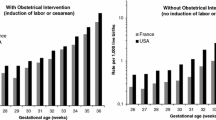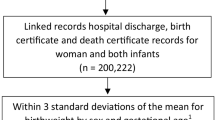Abstract
This study examined the impact of infant and maternal factors on preterm delivery and low birthweight (LBW) in Alberta between January 1, 1994 and December 31, 1996. Data on 113,994 births were collected from vital statistics registration birth data. Logistic regression models for preterm and LBW delivery suggested the key risk factors were multiple and still birth (odds ratios >22.0). Other characteristics included female gender, birth defects, nulliparous women, maternal age 35 and greater, unmarried, history of abortion, maternal smoking, maternal street drug use, and having less than 4 prenatal visits (odds ratios 0.86–2.54). Interactions between smoking and alcohol, and smoking and parity were noted. Efforts to improve the currently low rates (8.2%) of smoking cessation during pregnancy are required. Social, economic and medical factors associated with delayed childbearing and birth outcomes should be investigated.
Résumé
L’étude porte sur l’influence des caractéristiques de la mère et du nourrisson sur les accouchements prématurés et l’insuffisance de poids à la naissance (IPN) en Alberta entre le 1er janvier 1994 et le 31 décembre 1996. Nous avons recueilli des données sur 113 994 naissances à partir des inscriptions aux registres d’état civil. Selon nos modèles de régression logistique pour les accouchements prématurés et l’IPN, les principaux facteurs de risque auraient été les accouchements multiples ou de bébés morts-nés (ratios d’incidence approchés >22,0). Les autres caractéristiques étaient le sexe féminin, les anomalies congénitales, la nulliparité et le fait pour la mère d’avoir 35 ans ou plus, d’être célibataire, d’avoir déjà avorté, de fumer, d’utiliser des drogues illicites ou d’avoir effectué moins de quatre visites prénatales (ratios d’incidence approchés 0,86–2,54). Nous avons constaté des interactions entre le tabagisme et l’alcool, et entre le tabagisme et le rang des naissances. Il faudrait s’efforcer d’améliorer les faibles taux de renoncement au tabac durant la grossesse (8,2 % actuellement) et étudier les facteurs sociaux, économiques et médicaux associés à la procréation tardive et à l’issue de la grossesse.
Similar content being viewed by others
References
Tough SC, Svenson L, Schopflocher D. Maternal Risk Factors in Relationship to Birth Outcome. Edmonton, AB: Alberta Health and Wellness, July 1999.
Chomitz VR, Lilion WY, Cheung D, Lieberman E. The role of lifestyle in preventing low birth-weight. The Future of Children 1995;5(1):121–138.
Miller CA, Fine A, Adams-Taylor S. Monitoring Children’s Health: Key Indicators. Washington: American Public Health Association, 1989.
Bakketeig LS, Jacobson G, Hoffman HJ, et al. Pre-pregnancy risk factors for small-for-gestation-al age births among parous women in Scandanavia. Acta Obstet Gynecol Scand 1993;72(4):273–279.
Kramer MS. Determinant of low birth weight: Methodological assessment and meta-analysis. Bull World Health Organ 1987;65:663–737.
McCormick MC. The contribution of low birth-weight to infant mortality and childhood morbidity. N Engl J Med 1985;312:82–90.
Svenson L, Schopflocher D. Hospitalizations by Birth Weight. Results from the Alberta Children’s Health Study. Graph of the Week, Number 44. Edmonton, AB: Alberta Health and Wellness, 1997.
Svenson L, Schopflocher D. Birthweight and the Use of Physician Services: Results from the Alberta Children’s Health Survey. Graph of the Week, Number 45. Edmonton, AB: Alberta Health and Wellness, 1997.
Hack M, Taylor HG, Klein N, et al. School-age outcomes in children with birth weights under 50g. N Engl J Med 1994;331:753–759.
Saigal S, Feeny D, Rosenbaum P, et al. Self-perceived health status and health-related quality of life of extremely low-birth-weight infants at adolescence. JAMA 1996;276:453–459.
Zimmer-Gembeck MJ, Helfand M. Low birth-weight in a public prenatal care program: Behavioral and psychosocial risk factors and psychosocial intervention. Soc Sci Med 1996;43:187.
WuWen S, Liu S, Marcoux S, Fowler D. Uses and limitations of routine hospital admission/separation records for perinatal surveillance. Chron Dis Can 1997;18(3):113–119.
Harlow BL, Frigoletto F, Cramer DW, et al. Determinants of preterm delivery in low-risk pregnancies. J Clin Epidemiol 1996;49:441–448.
Creasy RK. Ways of preventing preterm birth. Contemp Obstet Gynecol 1988;32:64–77.
Center for Health Economics Research. Access to Health Care: Key Indicators for Policy. Princeton, NJ: The Robert Wood Johnson Foundation, 1993.
Tough SC, Greene C, Svenson L, et al. What is the contribution of in vitro fertilization to population changes in rates of low birth weight, preterm delivery and multiple birth? [abstract]. Pediatr Res 1999;45(4):257A.
Canadian Institute of Child Health. The Health of Canada’s Children: A CICH Profile, 2nd ed. Ottawa, ON: Canadian Institute of Child Health, 1995.
Kramer MS, Platt R, Yang H, et al. Secular trends in preterm birth. A hospital based cohort study. JAMA 1998;280:1849–1854.
Lang JM, Lieberman E, Cohen A. A comparison of risk factors for preterm labour and term small for gestational age birth. Epidemiology 1996;7:369–376.
Heikkinen T, Alvesalo L, Osborne RH, Tienari J. Maternal smoking and tooth formation in the foetus. III. Thin mandibular incisors and delayed motor development at 1 year of age. Early Hum Dev 1997;47:327–340.
Rantakallio P. A follow up study up to the age of 14 of children whose mothers smoked during pregnancy. Pediatr Scand 1983;72:747–753.
Nayeye RL. Influence of maternal cigarette smoking during pregnancy on fetal and childhood growth. Obstet Gynecol 1981;57:18–21.
Tappin DM, Ford R, Nelson KP, Wild CJ. Prevalence of smoking in early pregnancy by census area: Measured by anonymous cotinine testing of residual antenatal blood samples. NZ Med J 1996;109(1018):101–103.
Dodds L. Prevalence of smoking among pregnant women in Nova Scotia from 1988–1992. CMAJ 1995;152(2):185–290.
Stewart PJ, Potter J, Dulberg C, et al. Change in smoking prevalence among pregnant women 1982–93. Can J Public Health 1995;86(1):37–41.
United States Public Health Service, Department of Health and Human Service, Office on Smoking and Health. The Health Benefits of Smoking Cessation: A Report of the Surgeon General. Rockville, MD: United States Department of Health and Human Services, 1990. DHHS publication no. (CDC)90–8416.
Randall CL, West JR, Savage DD, et al. Symposium: New directions in Fetal Alcohol Syndrome research. Alcohol Clin Exp Res 1996;suppl 20(8):72A–77A.
Chiriboga CA. Fetal effects. Neurol Clin 1991;11:707–728.
Ouellette EM, Rosett HL, Rosman NP, Weiner L. Adverse effects on offspring of maternal alcohol abuse during pregnancy. N Engl J Med 1977;297:529–530.
McDonald AD, Armstrong BG, Sloan M. Cigarette, alcohol, and coffee consumption and prematurity. Am J Public Health 1992;82:87–90.
Sokol RJ, Miller SI, Reed G. Alcohol abuse during pregnancy; An epidemiologic study. Alcohol Clin Exp Res 1980;4:135–140.
Day NL, Richardson GA, Geva K, Robles N. Alcohol, marijuana, and tobacco: Effects of prenatal exposure on offspring growth and morphology at age six. Alcohol Clin Exp Res 1994;18(4):786–794.
McCance-Katz EF. The consequences of maternal substance abuse for the child exposed in utero. Psychosomatics 1991;32:268–274.
Griffith DR, Azuma SD, Chasnoff IJ. Three year outcome of children exposed prenatally to drugs. J Am Acad Child Adolesc Psychiatry 1994;33(1):20–27.
Richardson GA, Day NL, Goldschmidt L. Prenatal alcohol, marijuana and tobacco use: Infant mental and motor development. Neurotoxicol Teratol 1995;17(4):479–487.
Astley SJ, Little RE. Maternal marijuana use during lactation and infant development at one year. Neurotoxicol Teratol 1990;12:161–168.
Ryan L, Ehrlish S, Finnegan L. Cocaine abuse in pregnancy: Effects on the fetus and newborn. Neurotoxicol Teratol 1987;9:295–299.
Collins E, Hardwick R, Jeffery H. Perinatal cocaine intoxication. Med J Aust 1989;150:331.
Van Baar AL, Fleury P, Soepatmi S, et al. Neonatal behaviour after drug dependent pregnancy. Arch Dis Child 1989;54:235–240.
Behnke M, Eyler FD, Conlon M, et al. How fetal cocaine exposure increases neonatal hospital costs. Pediatrics 1997;99:204–208.
Joseph KS, Kramer MS, Marcoux S, et al. Determinants of preterm birth rates in Canada from 1981 through 1983 and from 1992 through 1994. N Engl J Med 1998;339(20):1434–1439
Author information
Authors and Affiliations
Corresponding author
Rights and permissions
About this article
Cite this article
Tough, S.C., Svenson, L.W., Johnston, D.W. et al. Characteristics of Preterm Delivery and Low Birthweight Among 113,994 Infants in Alberta: 1994–1996. Can J Public Health 92, 276–280 (2001). https://doi.org/10.1007/BF03404960
Received:
Accepted:
Published:
Issue Date:
DOI: https://doi.org/10.1007/BF03404960




